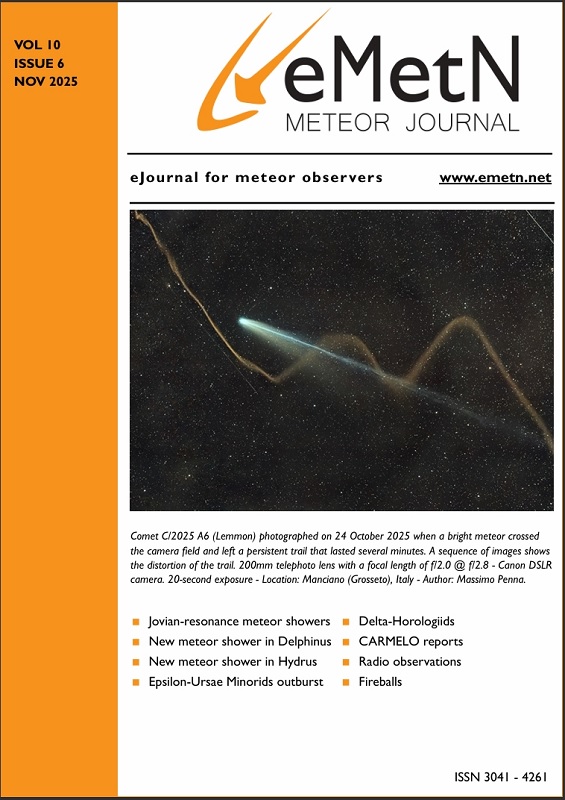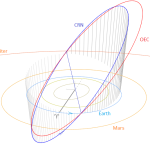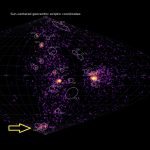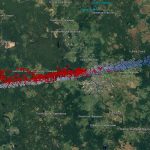By Paul Roggemans, Denis Vida and Damir Šegon
Abstract: A new meteor shower discovered in 2024 by GMN, registered by the IAU-MDC as M2024-S1 displayed distinct activity in 2025, September 21–23, from a radiant at R.A. = 242.0°, Decl. = +76.9°. The orbit obtained in 2024 has been confirmed. Asteroid 2021 HK12 is a likely parent body and the shower may be dynamically connected with the epsilon-Ursae-Minorids (EPU#1044).
1 Introduction
In 2024 Global Meteor Network discovered a new activity source on 23–24 September 2024 which was reported to the IAU-MDC and listed with the temporary identification M2024-S1 (Vida and Šegon, 2024; Šegon et al., 2025). This activity source has been detected again in 2025 (Figure 1) during the nights September 21–23. In total 89 meteors of this meteor shower were observed by the Global Meteor Network low-light video cameras during the period 2025 September 19 – 30 with most events during September 21 – 24. The shower was independently observed by cameras in 20 countries (Bosnia Herzegovina, Belgium, Bulgaria, Canada, Croatia, Czechia, Denmark, Germany, France, Hungary, Italy, Netherlands, Poland, Portugal, Romania, Slovenia, South Korea, Spain, United Kingdom and United States). The shower had a median geocentric radiant with coordinates R.A. = 242.0°, Decl. = +76.9°, within a circle with a standard deviation of ±2.2° (equinox J2000.0) see Figure 2. The radiant drift in R.A. is –0.34° on the sky per degree of solar longitude and –0.10° in Dec., both referenced to λʘ = 181.4° (Figures 3 and 4). The median Sun-centered ecliptic coordinates were λ – λʘ = 296.1°, β = +76.6° (Figure 5). The geocentric velocity was 31.8 ± 0.1 km/s.
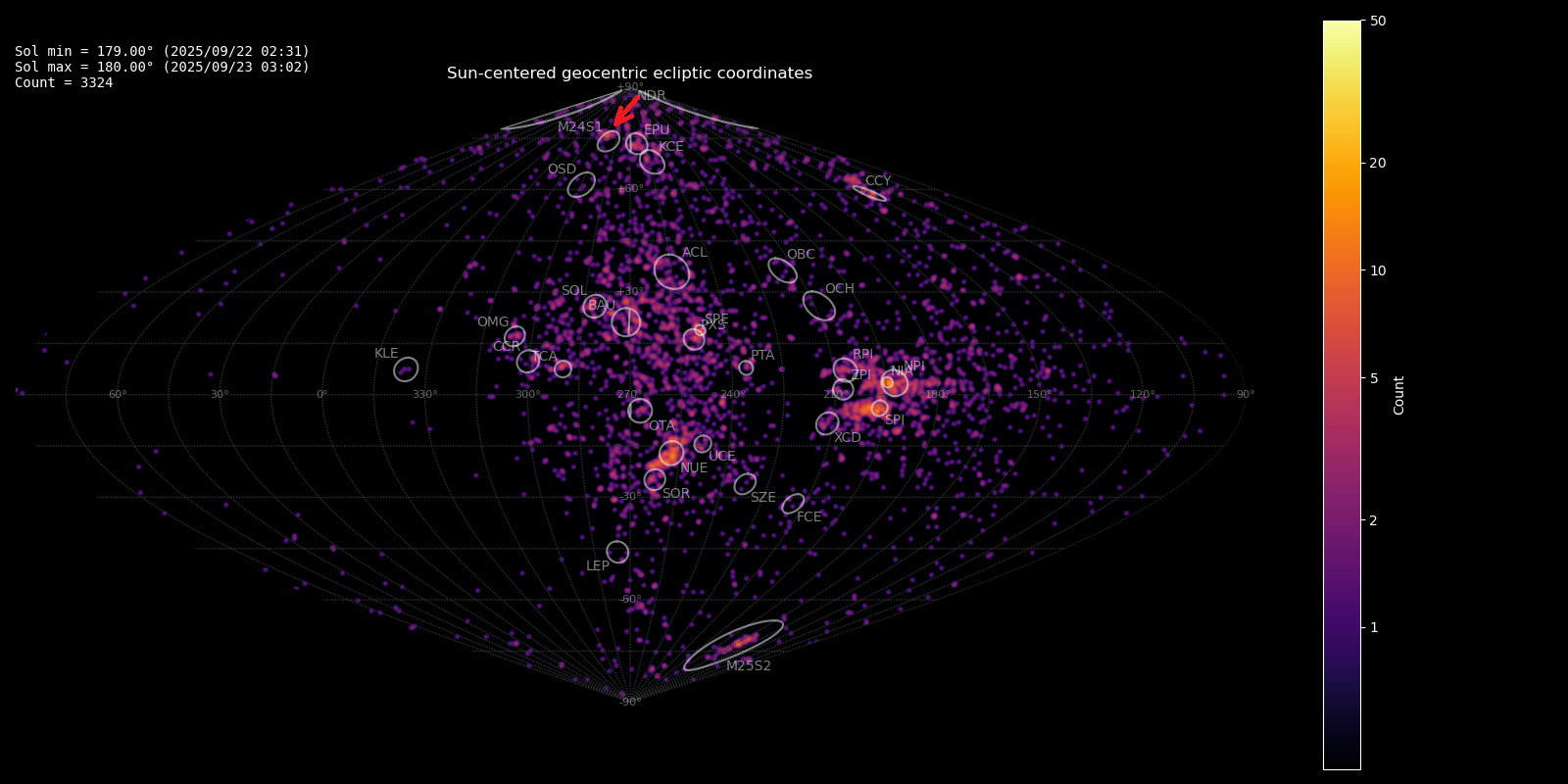
Figure 1 – Radiant plot of the Global Meteor Network data for 2025 September 22–23 in Sun-centered geocentric ecliptic coordinates. The new radiant is visible at high ecliptic altitude and marked by a red arrow.
2 GMN shower identification results
The GMN shower association criterion assumes that meteors within 1° in solar longitude, within an association radius from radiant (4.8° in this case), and within 10% in geocentric velocity of a shower reference location are members of that shower. Further details about the shower association are explained in Moorhead et al. (2020). Using these meteor shower selection criteria, 89 orbits have been associated in 2025 with M2024-S1. The mean orbit has been listed in Table 1.
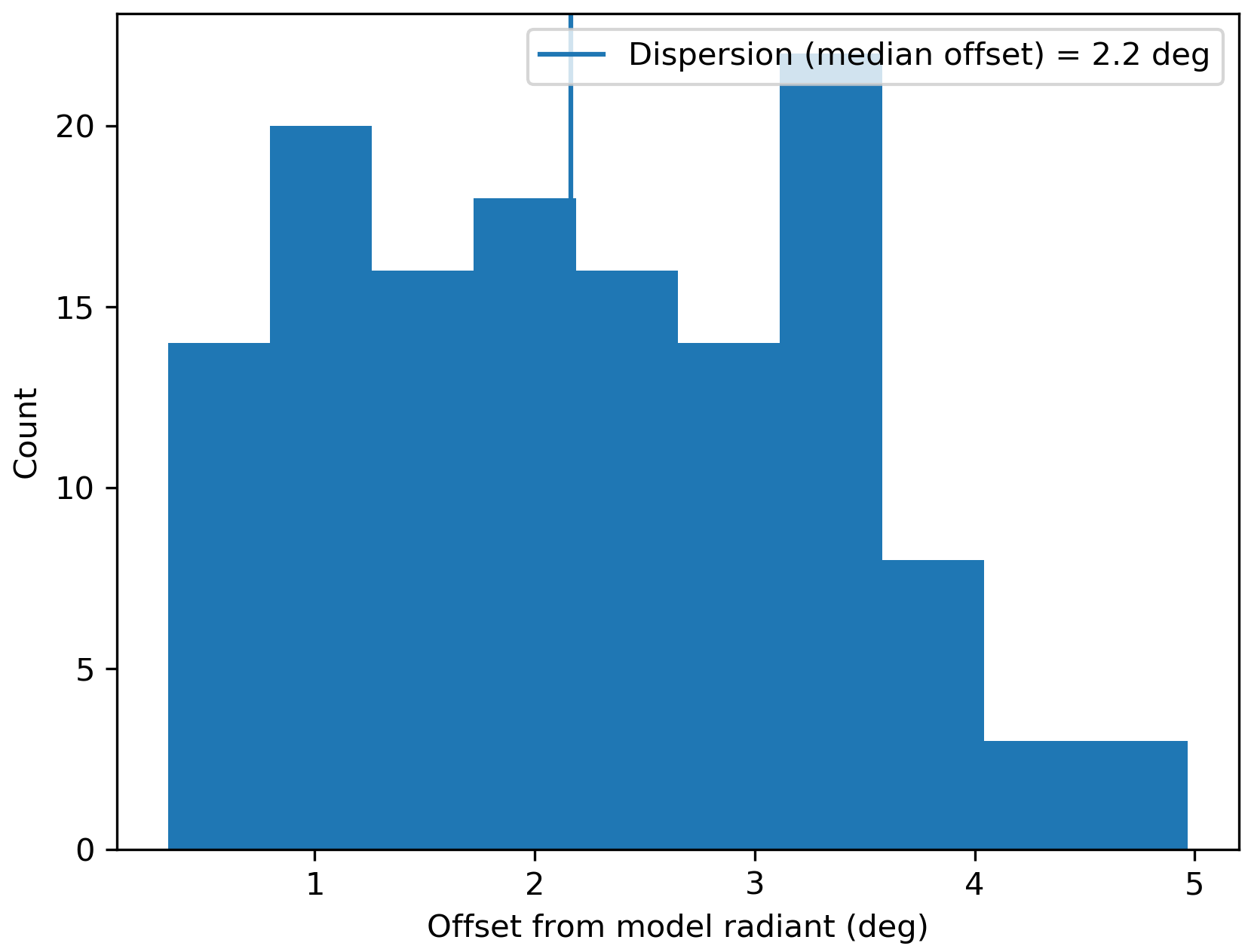
Figure 2 – Dispersion on the radiant position.
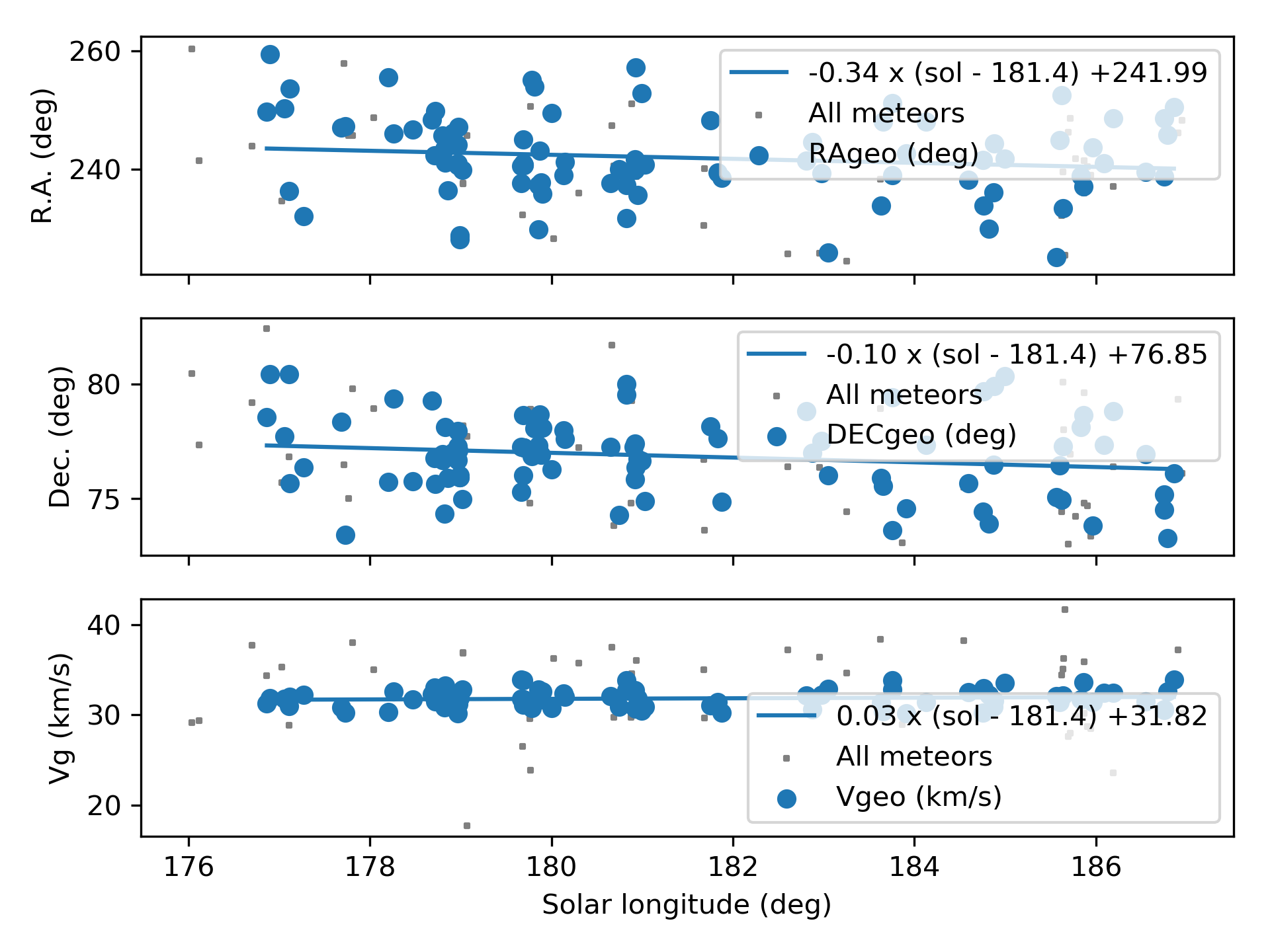
Figure 3 – The radiant drift.
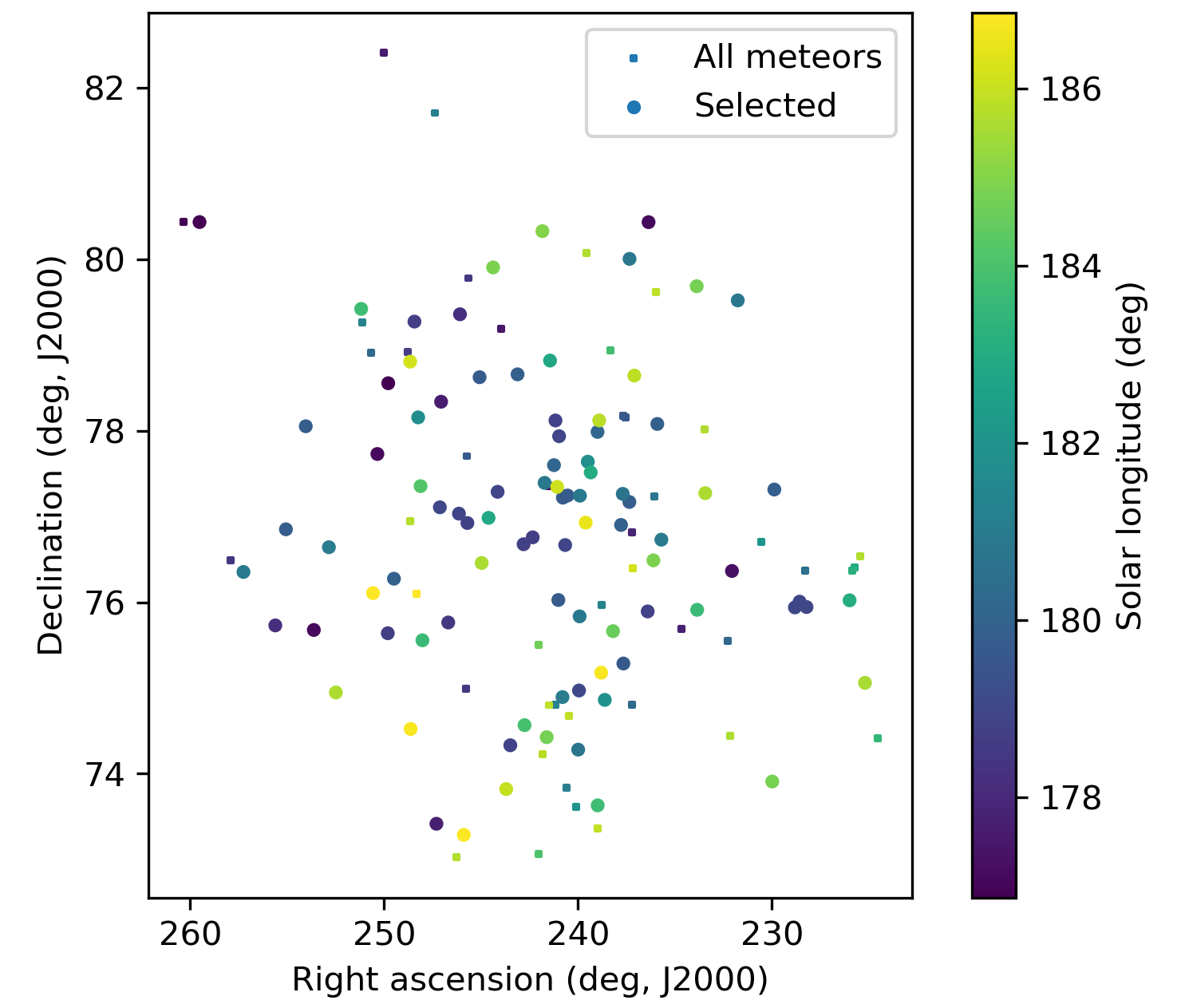
Figure 4 – The radiant distribution during the solar-longitude interval 176° – 187° in equatorial coordinates.
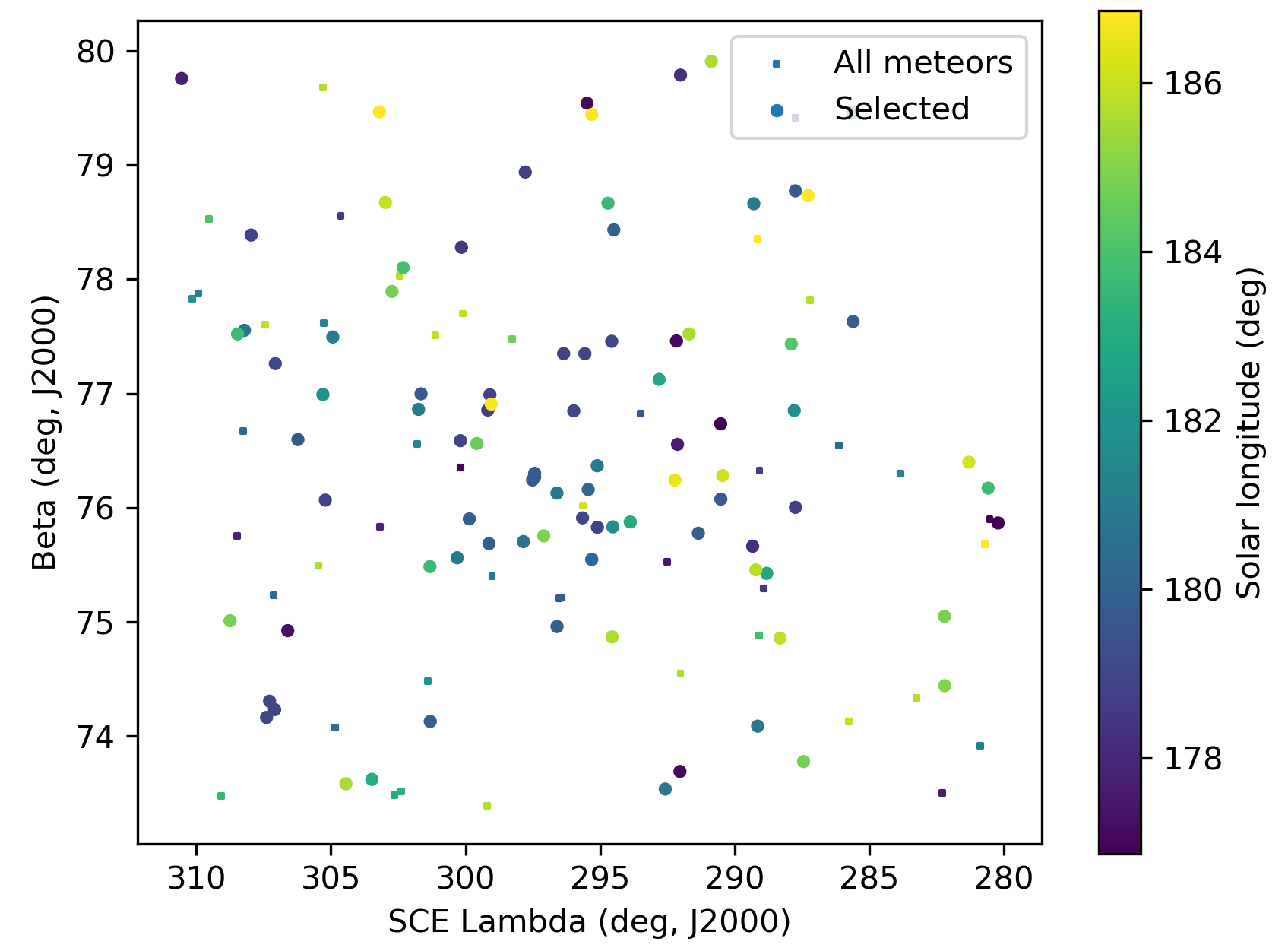
Figure 5 – The radiant distribution during the solar-longitude interval 176° – 187° in Sun centered geocentric ecliptic coordinates.
3 Another search method
Meteor shower identification strongly depends on the methodology used to select candidate shower members. The sporadic background is everywhere present at the sky which risks to contaminate selections of shower candidates. Using a radiant location is a straightforward method to classify shower meteors. In order to double check GMN meteor shower detections another method is used, based on orbit similarity criteria. This approach serves as a second opinion to make sure that no spurious radiant concentrations are mistaken as new meteor showers.
The visible concentration of radiant points was extracted for the time interval of 178° < λʘ < 184°, arbitrarily limited in Sun-centered geocentric ecliptic coordinates with
282° < λ–λʘ < 306° and +71° < β < +78°. This selection includes most of the possible meteor shower members as well as the sporadic sources within this interval. This preselection included 72 meteor orbits, used to compute a first mean orbit for this sample. We didn’t use median values to derive a mean orbit since a vectoral solution like the method of Jopek et al. (2006) is more appropriate for orbital elements with angular values.
This first mean orbit serves as a reference orbit to start an iterative procedure to approach a mean orbit which is the most representative orbit for the similar orbits within the sample, removing outliers and sporadic orbits. This method has been described before (Roggemans et al., 2019). Three different discrimination criteria are combined in order to have only those orbits which fit the different criteria thresholds. The D-criteria that we use are these of Southworth and Hawkins (1963), Drummond (1981) and Jopek (1993) combined. The values are considered in five different classes with different thresholds of similarity:
- Low: DSH < 0.2 & DD < 0.08 & DH < 0.2;
- Medium Low: DSH < 0.125 & DD < 0.05 & DH < 0.125;
- Medium high: DSH < 0.1 & DD < 0.04 & DH < 0.1;
- High: DSH < 0.075 & DD < 0.03 & DH < 0.075.
- Very high: DSH < 0.05 & DD < 0.02 & DH < 0.05.
Working with D-criteria requires caution as the validity depends much on the type of orbits. The method works fine for high inclined long period orbits, but is less reliable for low inclination, low eccentricity short period orbits. The D-criteria values are no more than an indication for the degree of similarity between an orbit and a reference orbit.
The Railey distribution fit pointed at a DD value of 0.05 as the orbital similarity threshold value cutoff for the 2024 data of this meteor shower (Šegon et al., 2025). We compare the radiant plots of 2024 with those of 2025. In 2024 the complete activity period between 176.0° and 187.0° in solar longitude was used, in 2025 the search interval was limited to 178.0° and 184.0° in solar longitude, to focus on the main activity nights and to exclude outliers at the outskirts of the activity period. Figure 6 compares the radiant plots in equatorial coordinates. The radiant appears at exactly the same position as in 2024. The activity was comparable to 2024.
The radiant concentration that we see at the top left of the plot for 2025 are the epsilon-Ursae-Minorids (EPU#1044), marked with a yellow diamond, which produced an outburst in 2025 (Roggemans et al., 2025). No concentration of radiants appeared at this position in 2024, indicating that no outburst occurred in 2024. In Figure 6 we see the same radiant plot, but in Sun-centered geocentric ecliptic coordinates. Also, here we see the M2024-S1 radiant well apart from the position of the epsilon-Ursae-Minorids (EPU#1044). In 2025 we see a distinct concentration of radiants at the position of this meteor shower. The radiant position obtained for the epsilon-Ursae-Minorids by GMN differs about 10° from the position listed in the IAU-MDC working list.
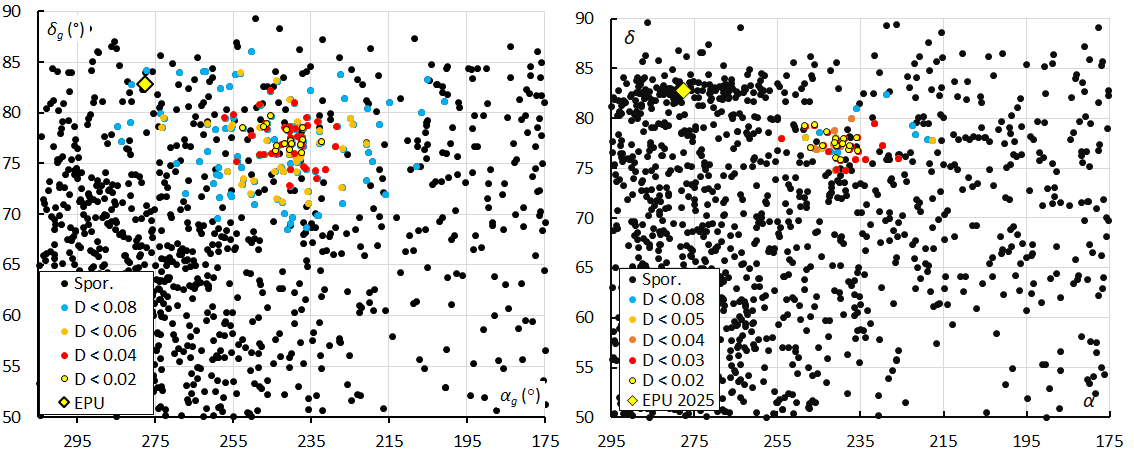
Figure 6 – The radiant distribution in equatorial coordinates, color coded for different threshold classes of the orbit similarity criteria. At left the plot for 2024 when M2024-S1 was discovered, λʘ[176.0–187.0], at right the plot for 2025, λʘ[178.0–184.0].
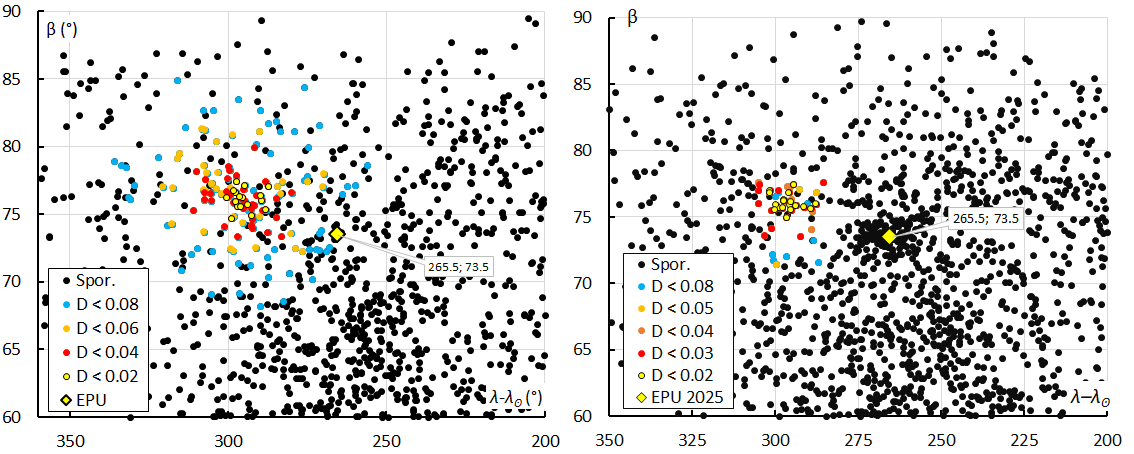
Figure 7 – The radiant distribution in Sun-centered geocentric ecliptic coordinates, color coded for different threshold classes of the orbit similarity criteria. At left the plot for 2024 when M2024-S1 was discovered, λʘ[176.0–187.0], at right the plot for 2025, λʘ[178.0–184.0].
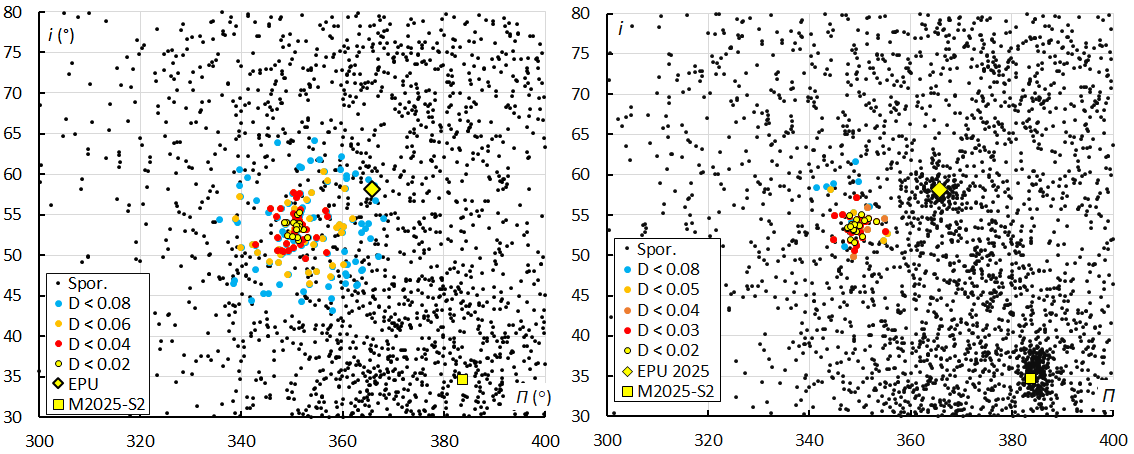
Figure 8 – Diagram of inclination i versus the longitude of perihelion Π, color coded for different threshold classes of the orbit similarity criteria. At left the plot for 2024 when M2024-S1 was discovered, sampled during the entire activity period, λʘ[176.0–187.0]. At right the plot for 2025, limited to the nights with highest activity λʘ[178.0–184.0]. The positions of two other outbursts in 2025, EPU#1044 and M2025-S2 are indicated by a yellow diamond and a yellow square.
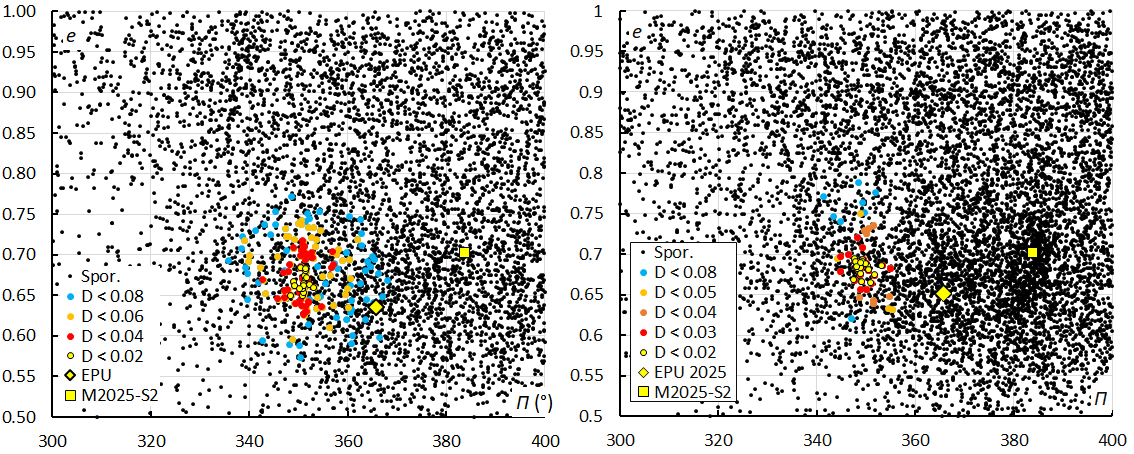
Figure 9 – Diagram of eccentricity e versus the longitude of perihelion Π, color coded for different threshold classes of the orbit similarity criteria. At left the plot for 2024 when M2024-S1 was discovered, sampled during the entire activity period, λʘ[176.0–187.0]. At right the plot for 2025, limited to the nights with highest activity λʘ[178.0–184.0]. The positions of two other outbursts in 2025, EPU#1044 and M2025-S2 are indicated by a yellow diamond and a yellow square.
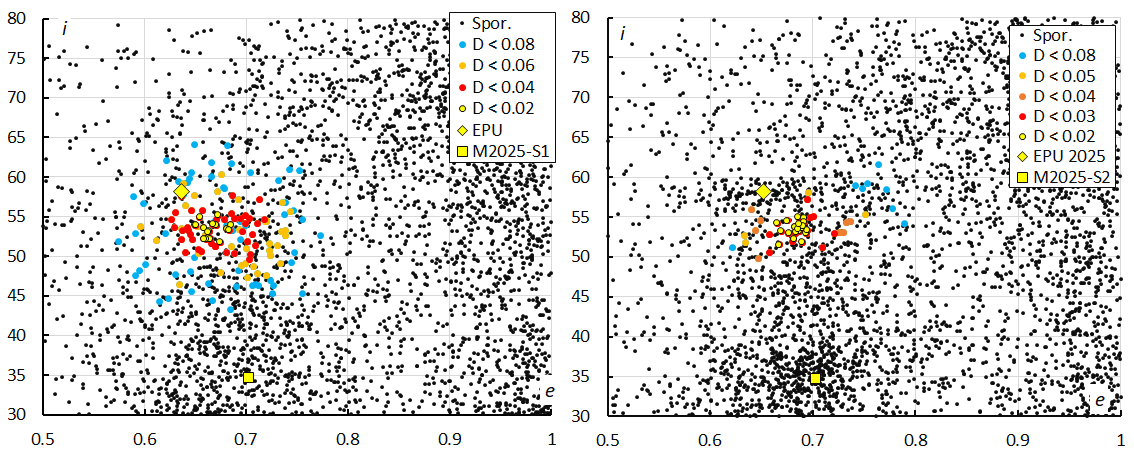
Figure 10 – Diagram of inclination i versus the eccentricity e, color coded for different threshold classes of the orbit similarity criteria. At left the plot for 2024 when M2024-S1 was discovered, sampled during the entire activity period, λʘ[176.0–187.0]. At right the plot for 2025, limited to the nights with highest activity λʘ[178.0–184.0]. The positions of two other outbursts in 2025, EPU#1044 and M2025-S2 are indicated by a yellow diamond and a yellow square.
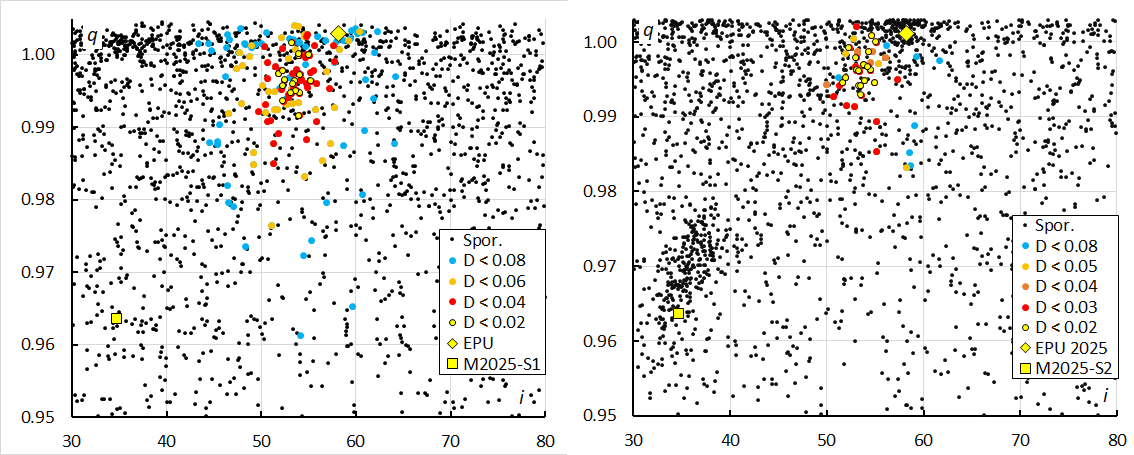
Figure 11 – Diagram of perihelion distance q versus the inclination i, color coded for different thresholds classes of the orbit similarity criteria. At left the plot for 2024 when M2024-S1 was discovered, sampled during the entire activity period, λʘ[176.0–187.0]. At right the plot for 2025, limited to the nights with highest activity λʘ[178.0–184.0]. The positions of two other outbursts in 2025, EPU#1044 and M2025-S2 are indicated by a yellow diamond and a yellow square.
Another way to visualize concentrations of meteoroid orbits is to plot the orbital elements against each other in a diagram. For orbits that belong to a meteoroid stream these parameters must appear as a concentration of points in each diagram. This way the compactness and dispersion of the stream for different orbital elements can be visualized.
Figure 8 compares inclination i against the longitude of perihelion Π for 2024 and 2025. M2024-S1 appears well concentrated in inclination and in longitude of perihelion. The blue dots in 2024 are outliers or chance-line-up sporadics, when the sampling bin is reduced to the same interval as used for 2025, most of these outliers disappear.
Figure 9 shows that M2024-S1 is also compact in eccentricity and longitude of perihelion. Figure 10 also shows the compactness in inclination and eccentricity. Figure 11 seems to have more dispersion in perihelion distance q but this is mainly due to the scale of the y-axis. Apart from the outliers recorded at the outskirts of the activity period, M2024-S1 appears as a distinct compact activity source.
4 Comparing both methods
The first method mainly looks at the radiant positions for the classification. When we apply the D criteria, only 69 of the 89 selected meteors fulfill the threshold values of DSH < 0.125, DD < 0.05 and DJ < 0.125 for the mean orbit obtained by the GMN method, five meteors fail completely in the D-criteria. 30 of the 89 meteors were identified by the GMN method before solar longitude 178.0° or after 184°. Twenty-one meteors within this interval were not detected by the D-criteria method and only two orbits detected by the D-criteria method were missed by the GMN method. 37 shower members were identified by both methods in common.
Despite the difference between the samples based on the two different methods, the final mean orbits are in very good agreement except for the radiant drift in R.A which is due to the short activity interval of only four days.
Table 1 – Comparing M2024-S1 for the 2024 and 2025 solutions derived by two different methods, the parameters under DD < 0.05 were derived from the method described in Section 3.
| GMN 2024 | GMN 2025 | DD < 0.05 | |
| λʘ (°) | 181.9 | 181.4 | 180.0 |
| λʘb (°) | 181.0 | 176.8 | 178.0 |
| λʘe (°) | 182.6 | 186.9 | 184.0 |
| αg (°) | 238.3 | 242.0 | 240.7 |
| δg (°) | +77.3 | +76.9 | +77.3 |
| Δαg (°) | – | –0.34 | –1.8 |
| Δδg (°) | – | –0.10 | -0.2 |
| vg (km/s) | 32.0 | 31.8 | 31.9 |
| Hb (km) | 89.7 | 94.3 | 92.1 |
| He (km) | 79.3 | 82.1 | 81.1 |
| Hp (km) | 82.7 | 86.0 | 84.3 |
| MagAp | –0.75 | +0.6 | –0.5 |
| λg (°) | 118.09 | 117.47 | 116.7 |
| λg – λʘ (°) | 296.19 | 296.07 | 296.5 |
| βg (°) | +75.80 | +76.56 | +76.0 |
| a (A.U.) | 3.11 | 3.275 | 3.15 |
| q (A.U.) | 0.994 | 0.995 | 0.995 |
| e | 0.680 | 0.696 | 0.684 |
| i (°) | 53.9 | 53.2 | 53.6 |
| ω (°) | 169.2 | 170.1 | 169.1 |
| Ω (°) | 181.8 | 181.4 | 180.4 |
| Π (°) | 351.0 | 351.5 | 349.6 |
| Tj | 2.34 | 2.27 | 2.33 |
| N | 31 | 89 | 40 |
5 Orbit and parent body
Figure 12 shows the orbits for the different solutions in the inner solar system. The dust of M2024-S1 crosses the Earth orbit at its descending node. The crossing of the ecliptic at the ascending node is close to the orbit of Jupiter what means that dust trails will be much affected by this giant planet’s gravitational perturbations. This could explain a periodic activity and reason why this shower wasn’t noticed sooner.
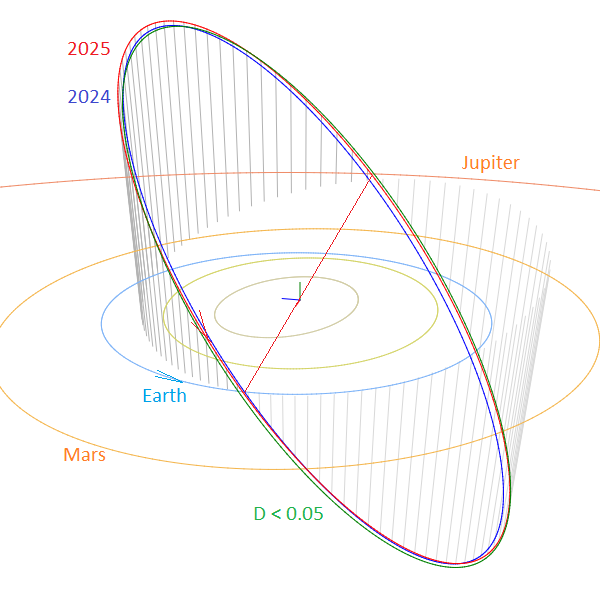
Figure 12 – Comparing the mean orbits for the solutions for M2024-S1 based on the shower identification according to two methods, blue is for 2024 data, red for 2025 data and green for the other shower search method with DD < 0.05 in Table 1, close-up at the inner Solar System. (Plotted with the Orbit visualization app provided by Pető Zsolt).
The Tisserand’s parameter relative to Jupiter, Tj identifies the orbit as of a Jupiter Family Comet type orbit. A parent-body search top 10 includes candidates with a threshold for the Drummond DD criterion value lower than 0.16 (Table 2). 2021 HK12 has a very similar orbit and could be the parent body. It would be up to meteoroid stream modelers to reconstruct the dynamic orbit evolution to see if there could be any connection between this object and this new meteor shower.
The list of possible parent bodies has nine candidates in common with those for the epsilon-Ursae Minorids (Roggemans et al., 2025). Apart from common candidate parent bodies, meteoroids from both streams ablate remarkable deep in the atmosphere. This means that the particles aren’t fragile dust typical for cometary material, but solid particles while the orbits nowhere get closer to the Sun than within the comfort zone of about 1 AU. The epsilon-Ursae Minorids produced an outburst in 2025, indicating a 6-year periodicity since its activity was recorded in 2019. M2024-S1 displayed distinct activity in 2024 and 2025 but remained below the threshold of detectability in earlier years. A small number of similar orbits can be found in years before 2024, but too few to be conclusive. There were no meteor camera networks with enough capacity to detect outbursts from weak sources like M2024-S1. Both showers, EPU#1044 and M2024-S1 cross the Earth’s orbit almost at the same time and also the points of their ascending nodes are relatively close to each other near Jupiter’s orbit. A common origin for both meteor showers is very likely.
Table 2 – Top ten matches of a search for possible parent bodies with DD < 0.16.
| Name | DD |
| 2021 HK12 | 0.051 |
| 2024 RK16 | 0.114 |
| 2009 SG18 | 0.128 |
| 2010 QA5 | 0.132 |
| 21P/Giacobini-Zinner | 0.141 |
| 2018 PF8 | 0.144 |
| 2020 UP3 | 0.145 |
| 2014 XX7 | 0.152 |
| 2021 VB4 | 0.156 |
| (163732) 2003 KP2 | 0.16 |
6 Conclusion
Activity from meteor shower M2024-S1 detected by Global Meteor Network in 2024 has been confirmed in 2025 with the same radiant position during 21–23 September, slightly earlier in time than in 2024 when it was observed on 23–24 September. The 2025 simultaneous outburst of the nearby epsilon-Ursae Minorids radiant resolved the confusion since other researchers regarded the M2024-S1 activity as a 2024 outburst of the epsilon-Ursae Minorids (Jenniskens et al., 2025). Both activity sources are different meteor showers, but dynamically related. A peculiar characteristic of this shower is the remarkable low ablation height of the meteors which indicate that the meteoroids consist of solid material. The asteroid or extinct comet 2021 HK12 is a plausible candidate as parent body. Future observations should clarify if the M2024-S1 activity is a periodic or an annual component. Orbit integrations may clarify the dynamic evolution and possible relationship with the epsilon-Ursae Minorids.
Acknowledgment
This report is based on the data of the Global Meteor Network (Vida et al., 2020a; 2020b; 2021) which is released under the CC BY 4.0 license. We thank all 825 participants in the Global Meteor Network project for their contribution and perseverance. A list with the names of the volunteers who contribute to GMN has been published in the 2024 annual report (Roggemans et al., 2025).
References
Drummond J. D. (1981). “A test of comet and meteor shower associations”. Icarus, 45, 545–553.
Harachka Y., Mikulich A., Morozov K., Angelsky A. (2024). “Possible new meteor shower in Ursa Minor”. eMetN Meteor Journal, 9, 395–396.
Jenniskens P., Johannink C., Moskovitz N., Howell A. (2025). “Short note on what appears to have been a 2024 outburst of epsilon-Ursae-Minorids (EPU#1044)”. eMetN Meteor Journal, 10, 20–21.
Jopek T. J. (1993). “Remarks on the meteor orbital similarity D-criterion”. Icarus, 106, 603–607.
Jopek T. J., Rudawska R. and Pretka-Ziomek H. (2006). “Calculation of the mean orbit of a meteoroid stream”. Monthly Notices of the Royal Astronomical Society, 371, 1367–1372.
Moorhead A. V., Clements T. D., Vida D. (2020). “Realistic gravitational focusing of meteoroid streams”. Monthly Notices of the Royal Astronomical Society, 494, 2982–2994.
Roggemans P., Johannink C. and Campbell-Burns P. (2019a). “October Ursae Majorids (OCU#333)”. eMetN Meteor Journal, 4, 55–64.
Roggemans P., Campbell-Burns P., Kalina M., McIntyre M., Scott J. M., Šegon D., Vida D. (2025). “Global Meteor Network report 2024”. eMetN Meteor Journal, 10, 67–101.
Roggemans P., Vida D., Šegon D. (2025). “Epsilon-Ursae Minorids (EPU#1044) enhanced activity in 2025”. eMetN Meteor Journal, 10, to be published.
Sato H., Jenniskens P., Howell A. (2020). “Epsilon Ursae Minorid Meteor Shower 2019”. CBET 4860.
Šegon D., Vida D., Roggemans P. (2025). “New meteor shower in Ursa Minor 23–24 September 2024”. eMetN Meteor Journal, 10, 12–19.
Southworth R. B. and Hawkins G. S. (1963). “Statistics of meteor streams”. Smithsonian Contributions to Astrophysics, 7, 261–285.
Vida D., Gural P., Brown P., Campbell-Brown M., Wiegert P. (2020a). “Estimating trajectories of meteors: an observational Monte Carlo approach – I. Theory”. Monthly Notices of the Royal Astronomical Society, 491, 2688–2705.
Vida D., Gural P., Brown P., Campbell-Brown M., Wiegert P. (2020b). “Estimating trajectories of meteors: an observational Monte Carlo approach – II. Results”. Monthly Notices of the Royal Astronomical Society, 491, 3996–4011.
Vida D., Šegon D., Gural P. S., Brown P. G., McIntyre M. J. M., Dijkema T. J., Pavletić L., Kukić P., Mazur M. J., Eschman P., Roggemans P., Merlak A., Zubrović D. (2021). “The Global Meteor Network – Methodology and first results”. Monthly Notices of the Royal Astronomical Society, 506, 5046–5074.
Vida D., Šegon D. (2024). New meteor shower M2024-S1 in Ursa minor. CBET 5452. D. W. E. Green (ed.), 1 pp.

